The derivative of tan 2x is 2 sec 2 (2x) (ie) d/dx tan 2x = 2 sec 2 (2x) Explanation We know that the derivative of tan x is sec 2 x (ie) d/dx (tan x) = sec 2 x According to the chain rule, d/dx tan 2x = sec 2 (2x) d/dx (2x) Therefore, d/dx tan 2x = 2 sec 2 (2x)מחשבונים לאלגברה, חשבון אינפיטיסימלי, גאומטריה, סטטיסטיקה, וכימיה כולל הדרךY=tanh^3 (2x) u=2x → du = 2dx y=tanh^3 (u) z=tanu → dz= 1 (tan u)^2 du y=z^3 →dy = 3z^2 dz dy = 3z^2 dz dy = 3 (tanu )^2 dz dy = 3 (tanu )^2 * (1 (tan u)^2) du dy = 3 (tan 2x )^2 * (1 (tan

Find The Derivative Of X Cosxtanx
Derivative of tan(2x+3)
Derivative of tan(2x+3)- Let y = tan (2x 3)We need to find derivative of y, ie 𝑑𝑦/𝑑𝑥 = (𝑑 tan〖(2𝑥3)〗)/𝑑𝑥 = sec2(2x 3) × (𝑑(2𝑥 3))/𝑑𝑥 = sec2 (2x 3) × 2 = 2 sec2 (2x 3) (As (tan x)' = sec2 x) (टीचू) Maths Science GST Accounts TaxDerivative of 2tan (2x) Simple step by step solution, to learn Simple, and easy to understand, so don`t hesitate to use it as a solution of your homework Below you can find the full step by step solution for you problem We hope it will be very helpful for you and it will help you to understand the solving process



Www Nuigalway Ie Media Publicsub Sites Engineering Files Differential Calculus 2 Pdf
Derivative calculator This calculator evaluates derivatives using analytical differentiation It will also find local minimum and maximum, of the given function The calculator will try to simplify result as much as possible Derivative Calculator Find Local Extrema (explained)Graph of tan x and its Derivative The graphs of \( \tan(x) \) and its derivative are shown below Derivative of the Composite Function tan (u(x)) We now have a composite function which is a function (tan) of another function (u)At a point , the derivative is defined to be This limit is not guaranteed to exist, but if it does, is said to be differentiable at Geometrically speaking, is the slope of the tangent line of at As an example, if , then and then we can compute The derivative is a
Answer to Find the derivative of f(x) = tan^{1}(3/ x) By signing up, you'll get thousands of stepbystep solutions to your homework questionsDerivative of (12x^3^4) מחשבון נגזרת Symbolab נגזרות נגזרת ראשונה נגזרת שנייה נגזרת שלישית נגזרת מסדר גבוה נגזרת בנקודה נגזרת חלקית נגזרת של פונקציה סתומה Objective 313 Compute the derivative of a polynomial Objective 314 Find where the tangent lines of a polynomial are horizontal Objective 315 Given the equation of a polynomial, use the rules of di erentiation to determine where the function is increasing, decreasing, concave up, concave down, or has a given slope Objective 316 Find
But before we do that, just a quick recap on the derivative of the tan function The derivative of tan(x) with respect to x is sec 2 (x) The derivative of tan(z) with respect to z is sec 2 (z) In a similar way, the derivative of tan(3x) with respect to 3x is sec 2 (3x) We will use this fact as part of the chain rule to find the derivative of tan(3x) with respect to x How to find the derivative of tan(3xThe derivative of `f(x)=tan(2x pi/2)` is `f'(x) = 2*sec^2(2x pi/2)` and at `x = 3*pi/4` the slope of the tangent is 2 You should remember that tangent function is rational, hence `f(x) = (sinCalculadoras gratuitas passo a passo para álgebra, trigonometria e cálculo




If Y Sqrt 1 Tan 2x 1 Tan 2x Then Dy Dx




Integration Of Inverse Tan 2x Integration By Parts Youtube
The Derivative Calculator supports computing first, second, , fifth derivatives as well as differentiating functions with many variables (partial derivatives), implicit differentiation and calculating roots/zeros You can also check your answers!Derivatives Derivative Applications Limits Integrals Integral Applications Integral Approximation Series ODE Multivariable Calculus Laplace Transform Taylor/Maclaurin Series Fourier Series Functions Line Equations Functions Arithmetic & Comp Conic Sections TransformationSolution for Use chain rule to find the derivative of the function below y = cot(t –) 10 y = E 10) y = tan(5 – sin 2x) y = (x5 – 1)2 y = 2(8x – 1)3
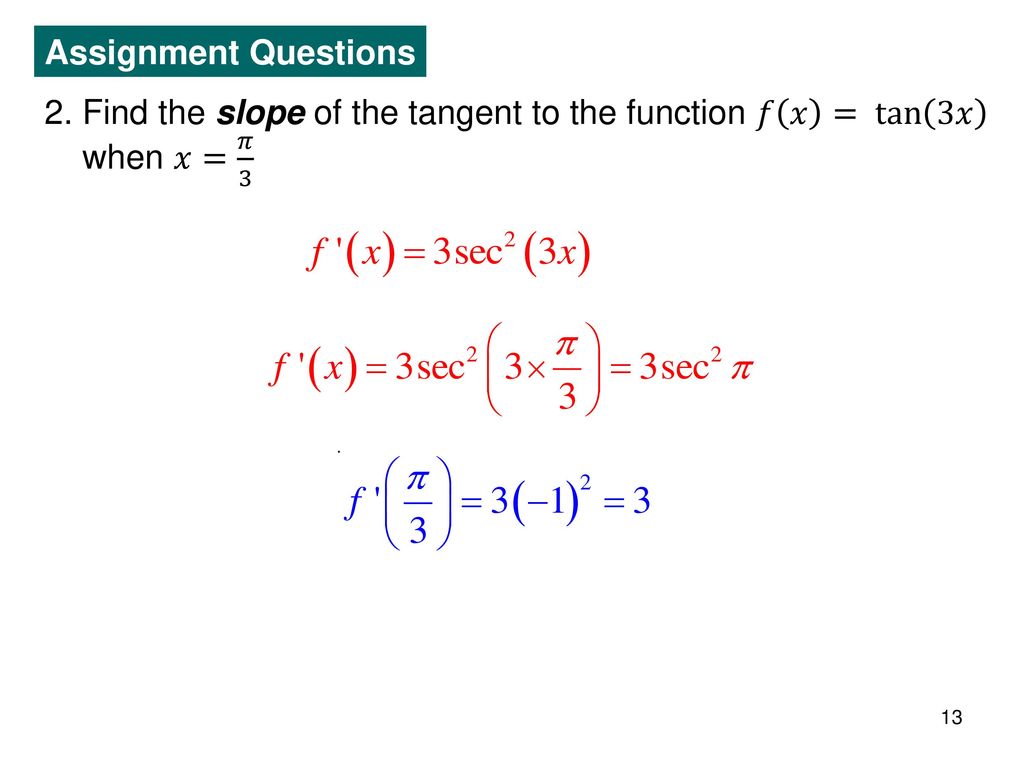



Derivatives Of Trigonometric Functions Ppt Download
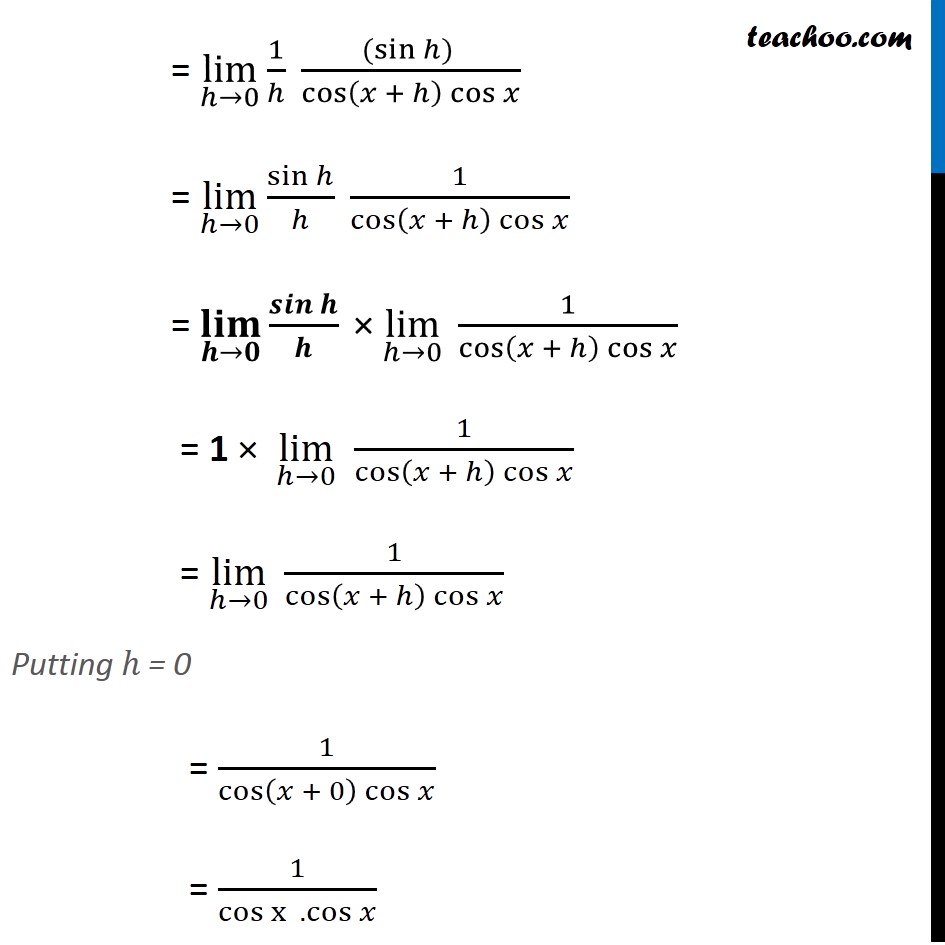



Prove That Derivative Of Tan X Is Sec 2 X By First Principle
Find the 2nd derivative of y 2x – 1 y = 2x 1 = 2 Differentiate x²y – xy2 x2 y2 = 0 Differentiate 3 y = 4cos (1) 4 y = x?sin (9) 5 y = 2csc(1 – 3x) 6 y = 9xsec (3) sin2x 7 y = 1cos2x tan 2x 8 y = x2 sinx sin²x cos2x sin2x7c cos2x 9 y = Invx3 INICAAnd so on Here are useful rules to help you work out the derivatives of many functions (with examples below)Note the little mark ' means derivative of, andThe derivative of x23x−2 tan x will be equal to 2x3−2 sec2x 2x−3−2sec2 x x23x−2sec2 x 2x3−2 cot x If you see that the given question has three function




Differentiation Of Tan 2 X And X 3 X 4 Youtube




Find D 2y Dx 2 If Y X 3 Tanx
4 Find the derivative of `y=(2x3)/(sin 4x)` Answer Put u = 2x 3 and also v = sin 4x Now `(dv)/(dx)=4 cos 4x` So making use of the quotient ascendancy, we have `(dy)/(dx) =(v(du)/(dx)u(dv)/(dx))/v^2` `=((sin 4x)(2)(2x3)(4 cos 4x))/(sin^2 4x)` `=(2 sin 4x4(2x3)cos 4x)/(sin^2 4x)` 5 Differentiate y = 2x sin x 2 cos x − x2cos x AnswerInteractive graphs/plots help visualize and better understand the functionsFind the derivative of the following w r t x by using method of first principle tan (2x 3) Mathematics and Statistics




Derivatives Of Tan X And Cot X Video Khan Academy




Ex 7 3 15 Integrate Tan3 2x Sec 2x Class 12 Ncert Ex 7 3
Learn how to solve differential calculus problems step by step online Find the derivative of 2tan(2x) The derivative of a function multiplied by a constant (2) is equal to the constant times the derivative of the function The derivative of the tangent of a function is equal to secant squared of that function times the derivative of that function, in other words, if {f(x) = tan(x)},Calculus Find the Derivative d/dx y=tan (2xx^3) y = tan (2x − x3) y = tan ( 2 x x 3) Differentiate using the chain rule, which states that d dx f (g(x)) d d x f ( g ( x)) is f '(g(x))g'(x) f ′ ( g ( x)) g ′ ( x) where f (x) = tan(x) f ( x) = tan ( x) and g(x) = 2x−x3 g ( x) = 2 x x 3The Derivative tells us the slope of a function at any point There are rules we can follow to find many derivatives For example The slope of a constant value (like 3) is always 0;
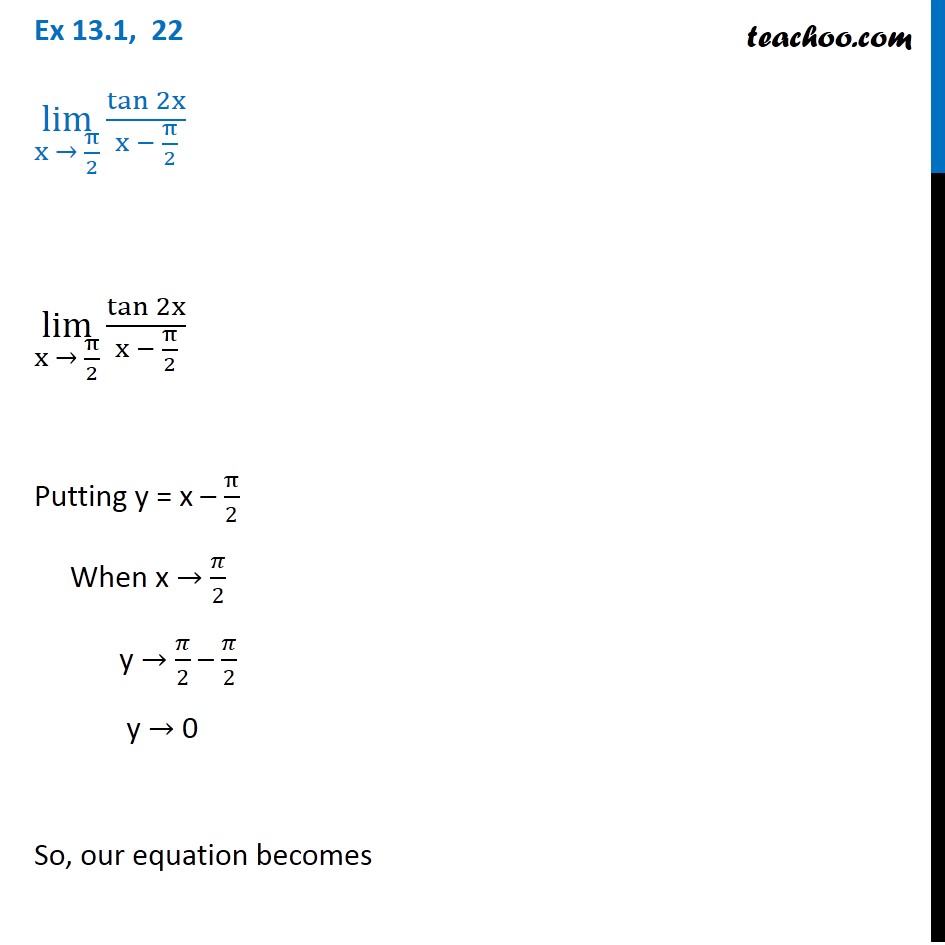



Ex 13 1 22 Lim X Pi 2 Tan 2x X Pi 2 Chapter 13 Class 11



Web Auburn Edu Holmerr 1617 Textbook Derivsummary Print Pdf
3 The instructions Use the definition of derivative to find f ′ ( x) if f ( x) = tan 2 ( x) I've been working on this problem, trying every way I can think of At first I tried this method lim h → 0 tan 2 ( x h) − tan 2 Find the derivative of the function tan (2x 3) from the definition (first principles) class12;Eg1 Write sinxcosxtanx as sin(x)cos(x)tan(x) 2 Write secx*tanx as sec(x)*tan(x) 3 Write tanx/sinx as tan(x)/sin(x) 4 Use inv to specify inverse and ln to specify natural log respectively Eg1 Write sin1 x as asin(x) 2 Write ln x as ln(x) 5 Sample Inputs for Practice Eg1 Write (10x2)(x 2) as 10*x2x^2 2 Write cos(x 3) as cos



Www Nuigalway Ie Media Publicsub Sites Engineering Files Differential Calculus 2 Pdf



1
Find given (3) 15 Find the derivative of f(x) =tan(sin(2x)), 1 16 Let h(x) = f($()) Use the table below to calculate the following derivatives 2 a (3) a) 0 5 1 0 S5 5810 9(*) (x) 2 15 b (2) 3 2 5 1 10 4 3 2 17 Determine the equation of the tangent line to the function (1) ==V5 r at x = 1Derivative of the function will be computed and displayed on the screen Click on 'Show a step by step solution' if you would like to see the differentiation steps Click on 'Draw graph' to display graphs of the function and its derivative Common errors while using derivative calculator find the derivative of tanx by first principle Mathematics TopperLearningcom iyyne Topperlearning CBSE Class 11science Ask The Expert Answered



1
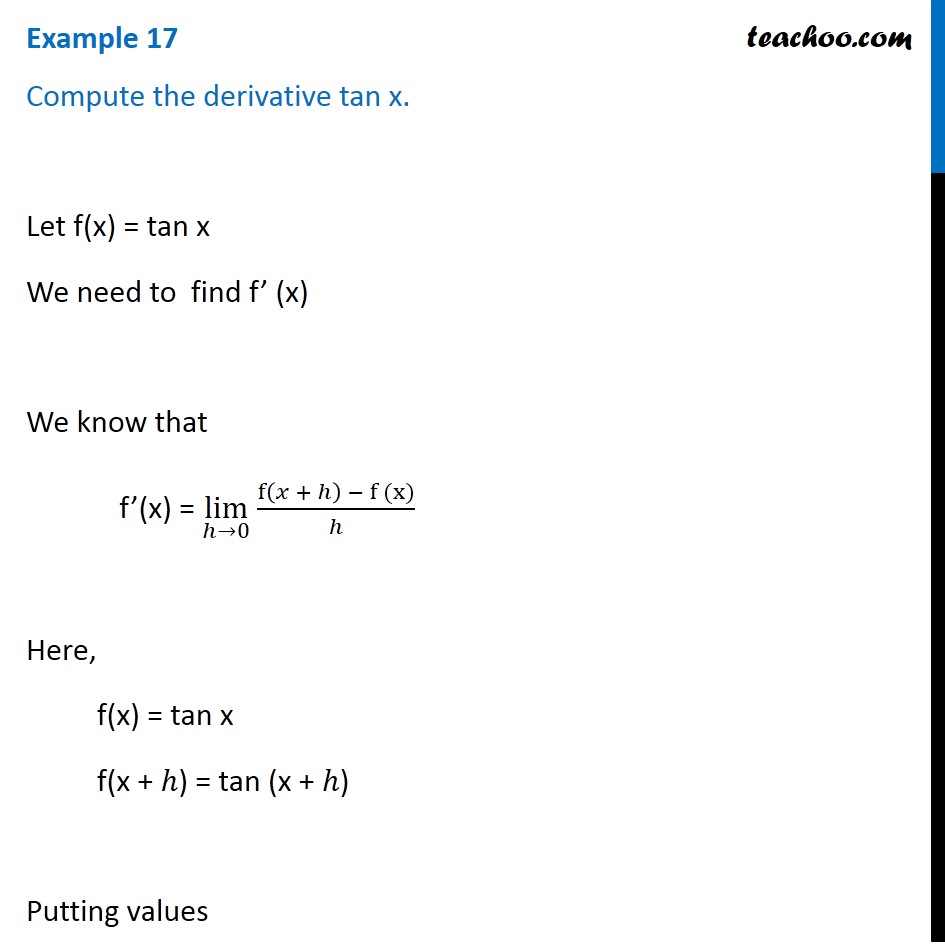



Prove That Derivative Of Tan X Is Sec 2 X By First Principle
To apply the Chain Rule, set u u as tan ( x) tan ( x) Differentiate using the Power Rule which states that d d u u n d d u u n is n u n − 1 n u n 1 where n = 3 n = 3 Replace all occurrences of u u with tan ( x) tan ( x) The derivative of tan(x) tan ( x) with respect to x x is sec2(x) sec 2 ( x) Reorder the factors of 3tan2(x)sec2Derivative of 3^(2x) Simple step by step solution, to learn Simple, and easy to understand, so don`t hesitate to use it as a solution of your homework Below you can find the full step by step solution for you problem We hope it will be very helpful for you and it will help you to understand the solving processJust for practice, I tried to derive d/dx (tanx) using the product rule It took me a while, because I kept getting to (1sin^2 (x))/cos^2 (x), which evaluates to sec^2 (x) tan^2 (x) Almost there, but not quite After a lot of fiddling, I got the correct result by adding cos^2 (x) to




Example 22 Find Derivative Of Tan 2x 3 Chapter 5 Class 12



Http Www Math Mcgill Ca Rags Jac Nyatest2p173 Pdf
Answer to Find the derivative of g(x) = x^3 tan(2x) By signing up, you'll get thousands of stepbystep solutions to your homework questions You About Press Copyright Contact us Creators Advertise Developers Terms Privacy Policy & Safety How works Test new features Press Copyright Contact us CreatorsActivity (Module 13) A Find the derivative of the following functions 1 y = Cos 8x 2 y = Sin (2x 5) 3 y = Sec 3x Tan 3x 4 y = 10 Csc x 2 5 w = 4 Cos2 1 2 y or w = 4 Cos = y 6 y = Tan (3x 2)



Http Www Stevejonak Com Test03 Addtional Review Pdf



2
The derivative of tan (2x) is equal to two times the secant squared of two times x Using mathematical notation, the equation is written as d/dx tan (2x) = 2sec^2 (2x) The derivative of tan (2x) can be found by using the quotient rule and the chain rule Using the quotient rule, the tangent of 2x can be simplified to read the cosine squared of If by tan − 1 you mean the inverse function of the restriction of tan to the interval ( − π / 2, π / 2), ie the function arctan, you can apply the general formula for the derivative of an inverse function (arctan) ′ (x) = 1 (tan) ′ (arctanx) = = 1 1 tan2(arctanx) = 1 1 x2 Share answered Mar 25 '19 at 2153Calculadoras gratuitas paso por paso para álgebra, Trigonometría y cálculo




Solving The Differential Equation Dy Dx Tan 2 X Y Youtube




Find The Derivative Of X Cosxtanx
The derivative is d tanx3 dx = d x3 dx ⋅ 1 cos2(x3) = 3x2 ⋅ ( 1 cos2(x3)) = 3x2 ⋅ sec2(x3) Answer linkFree derivative calculator differentiate functions with all the steps Type in any function derivative to get the solution, steps and graph From above, we found that the first derivative of sec(2x) = 2sec(2x)tan(2x) So to find the second derivative of sec(2x), we just need to differentiate 2sec(2x)tan(2x) We can use the chain rule to find the derivative of 2sec(2x)tan(2x) and it gives us a result of 8sec 3 (2x) – 4sec(2x) The second derivative of sec(2x) is 8sec 3 (2x) – 4sec(2x)




Larson Calculus 5 4 52 Find The Derivative Of Y E 2x Tan 2x With The Product Rule Youtube
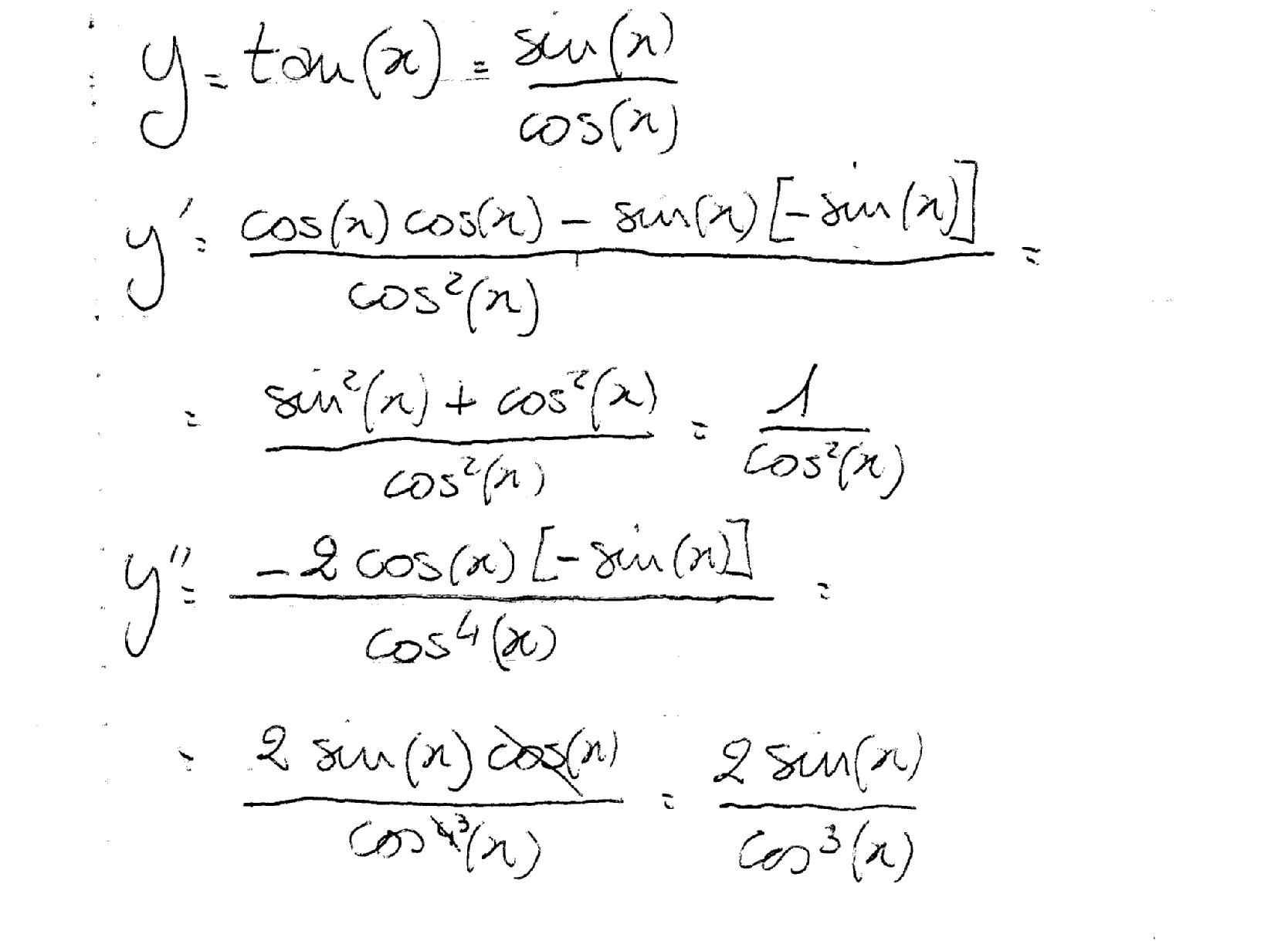



What Is The 2nd Derivative Of Y Tanx Socratic
The diameters of a circle are along 2x y 7 = 0 and x 3y 11 = 0 Then, the equation of this circle, which also passes through (5, 7), is The difference between degree and order of a differential equation that represents the family of curves given by y 2 = a (x (√a / 2)), a > 0 iSolution The derivative of this function is \{y'\left( x \right) }={ {\left( {\tan x \frac{1}{3}{{\tan }^3}x} \right)^\prime } } = {{\left( {\tan x} \rightY = tan^3(x) , find the derivative



2




Derivative Rules For Y Cos X And Y Tan X Calculus Socratic
Derivative of 13^ (2x) Derivative of 13^ (2x) Simple step by step solution, to learn Simple, and easy to understand, so don`t hesitate to use it as a solution of your homework Below you can find the full step by step solution for you problem We hope it will be very helpful for you and it will help you to understand the solving processHence, evaluating the derivative of the function using the quotient rule yields `f'(x) = ( 2tan x/(cos^2 x))/((1 tan x)^2)` Approved by eNotes Editorial Team We'll help your grades soarShare It On Facebook Twitter Email 1 Answer 1 vote answered by Reyansh (191k points) selected by faiz Best answer Let f(x) = tan(2x 3) ← Prev




Differentiate Tanx Tan 2x Tan 3x Tan 4x W R T X Youtube
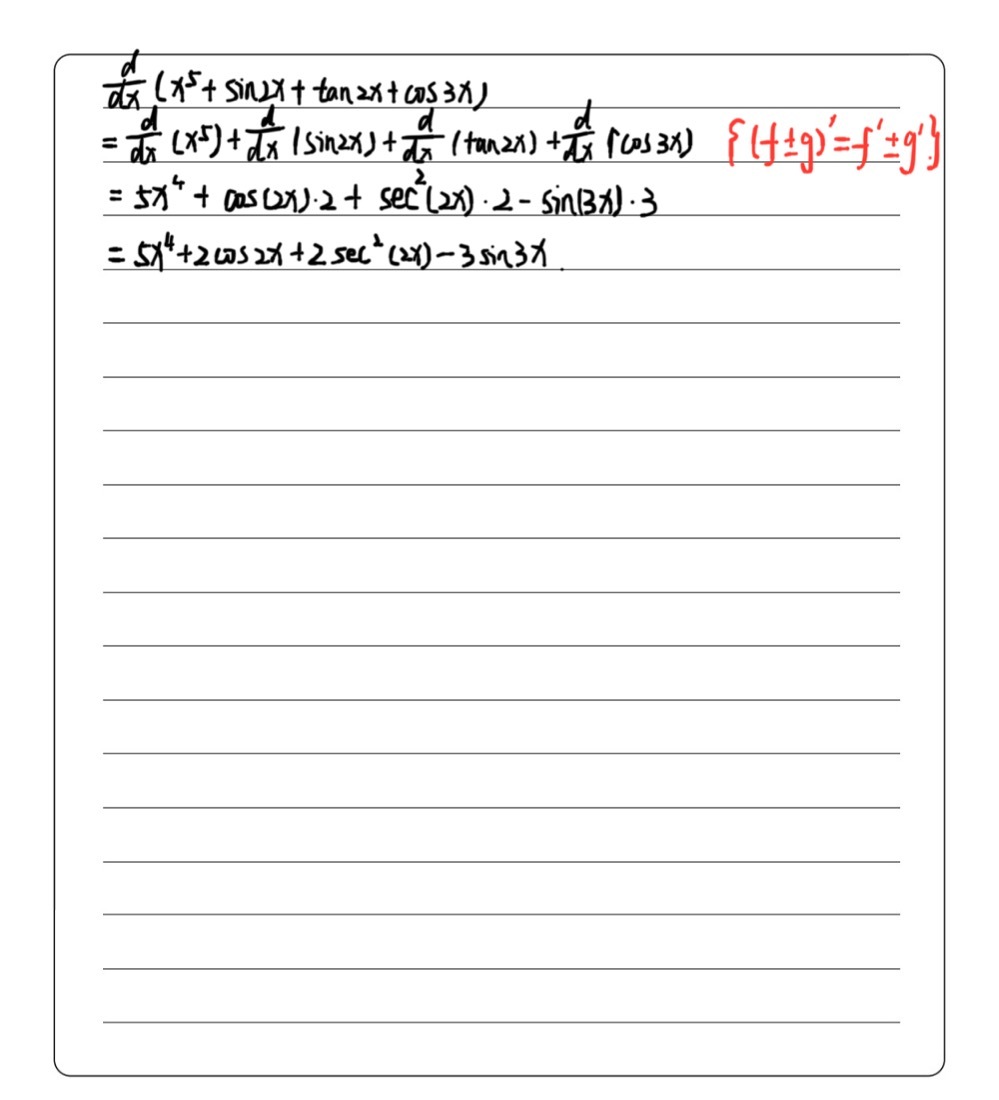



Me 21 If Fx X5 Sin 2x Tan 2x Cos 3x Then Deriv Gauthmath
Find the derivative of following functions wrt x tan (2x 3) Welcome to Sarthaks eConnect A unique platform where students can interact with teachers/experts/students to get solutions to their queries 3 Derivatives of the Inverse Trigonometric Functions by M Bourne Recall from when we first met inverse trigonometric functions " sin1 x" means "find the angle whose sine equals x" Example 1 If x = sin1 025 then by using the calculator, x = 15° We have found the angle whose sine is 025Let mathf(x)=\tan^3 (x)/math We can express mathf(x)/math as a composite function Let mathg(x)=x^3/math and mathh(x)= \tan (x)/math mathf(x)=g(h(x




Derivative Of Sec 3 2x




If Y 3 Log9 1 Tan 2x Then Dydx
The slope of a line like 2x is 2, or 3x is 3 etc;




Find The Derivative Of Tan 2x 3 Youtube



1
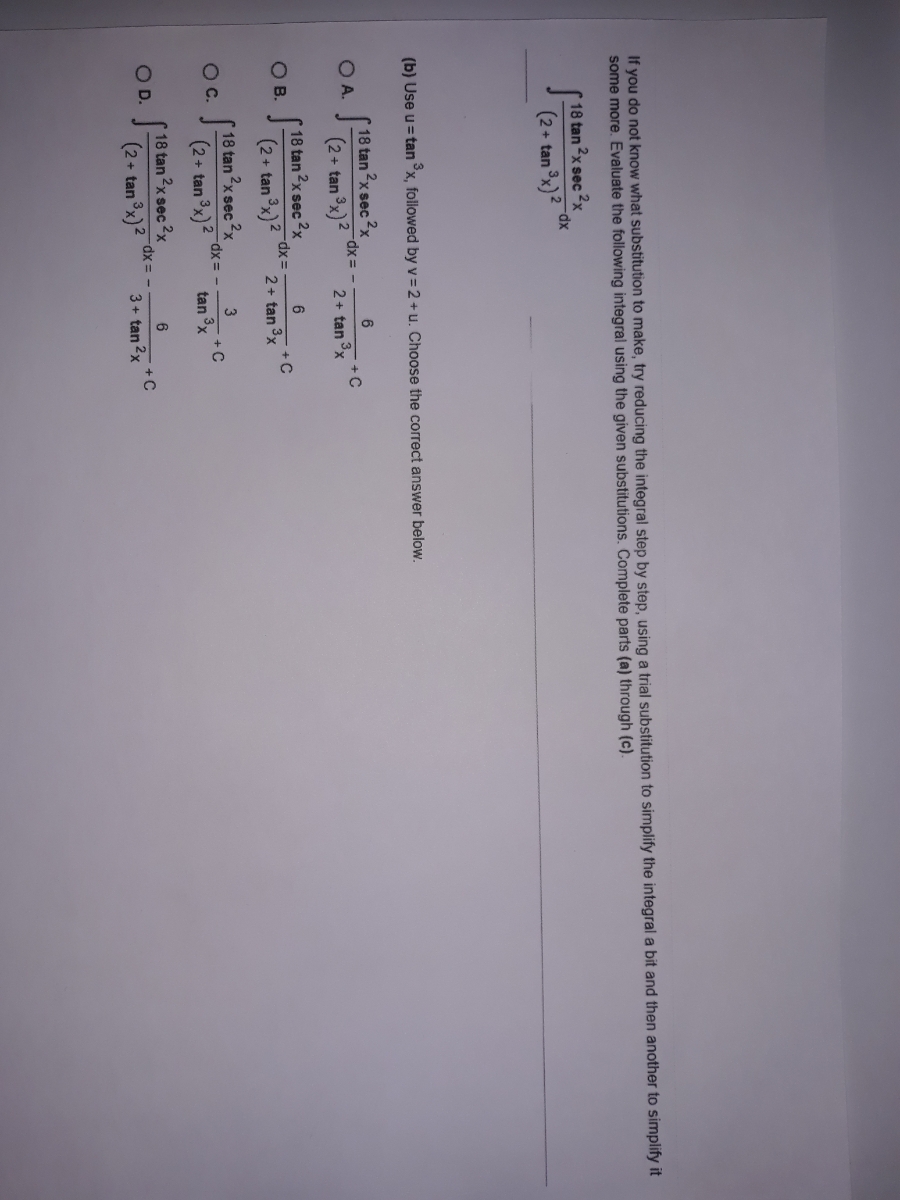



Answered If You Do Not Know What Substitution To Bartleby




Solved The Second Derivative Of Y Tan 2 X Is A Y 2 Chegg Com




Differentiate The Following From First Principle Tan2x Youtube



Orion Math Iastate Edu Miriamc M165f18 3 6bis Notes165 F18 Pdf




Implicit Differentiation Advanced Example Video Khan Academy



Www Math Purdue Edu Kyochman Ma Lesson14 Notes Implicitdifferentiation Pdf
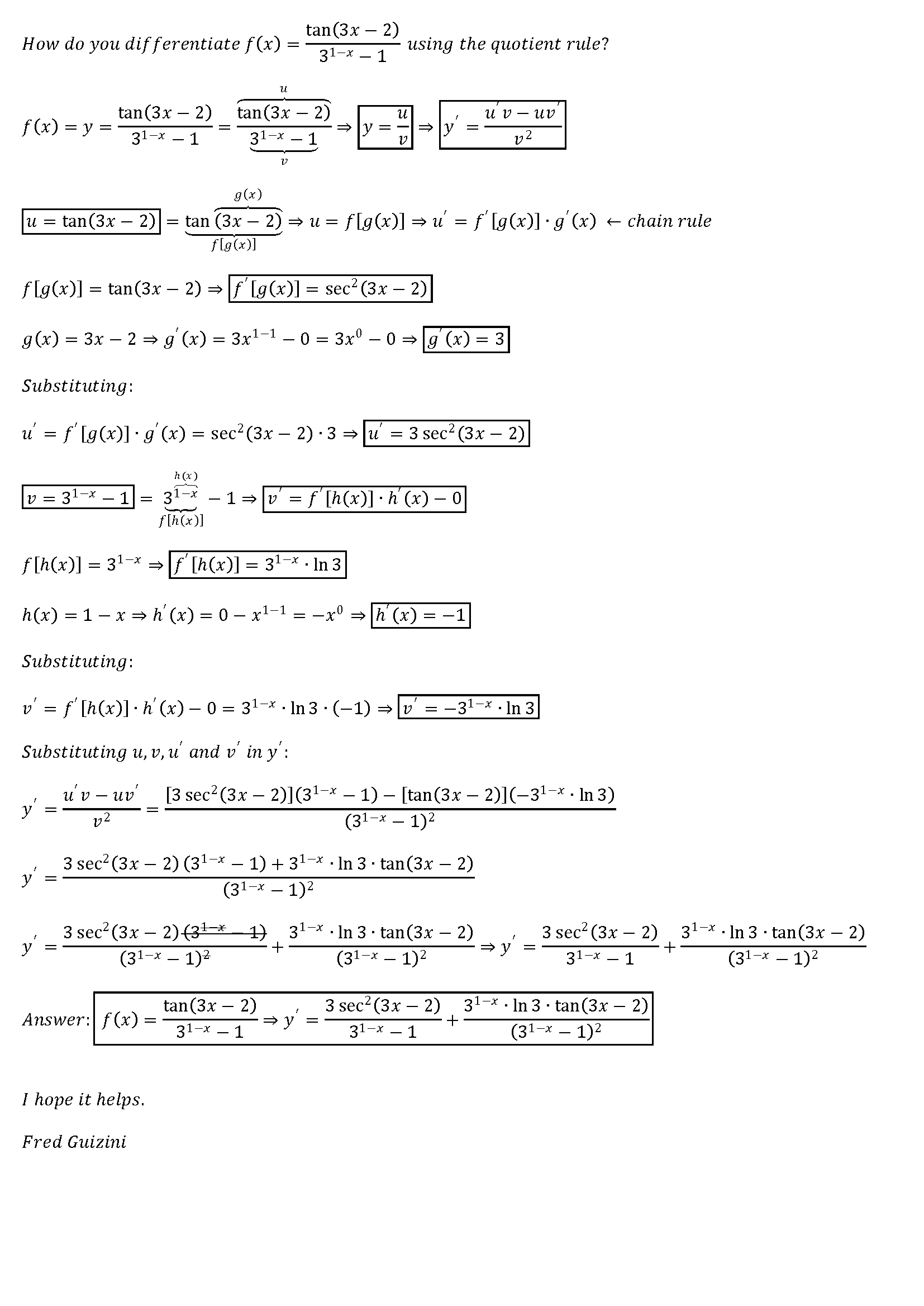



How Do You Differentiate F X Tan 3x 2 E 1 X 1 Using The Quotient Rule Socratic
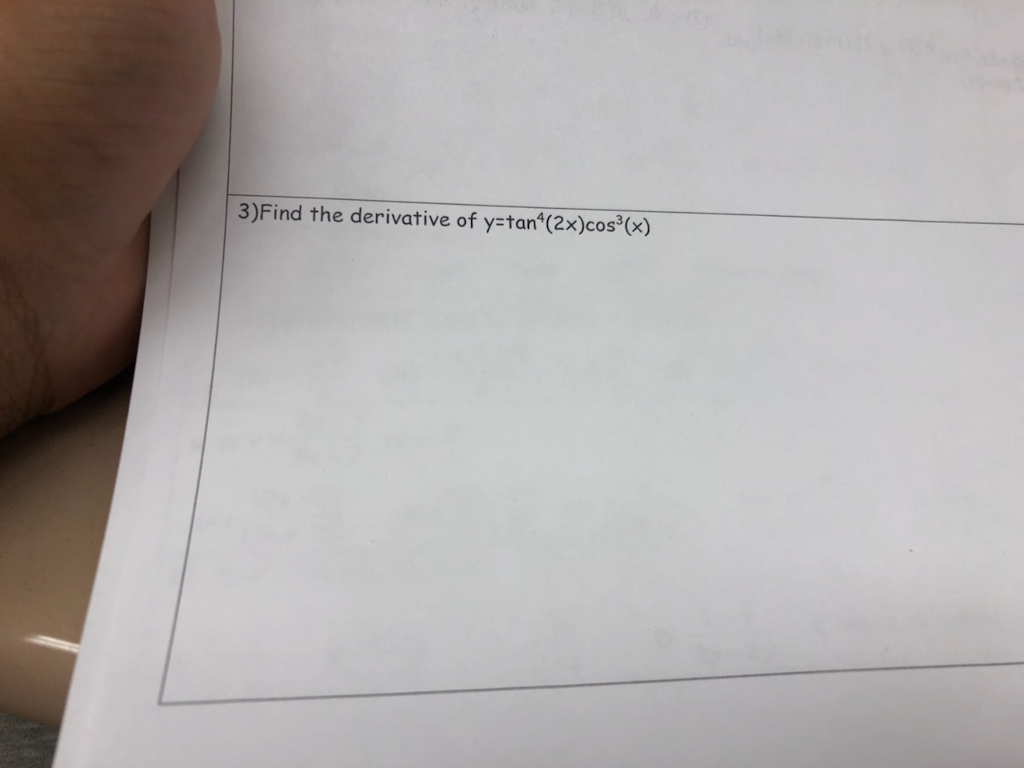



3 Find The Derivative Of Y Tan 2x Cos X Chegg Com
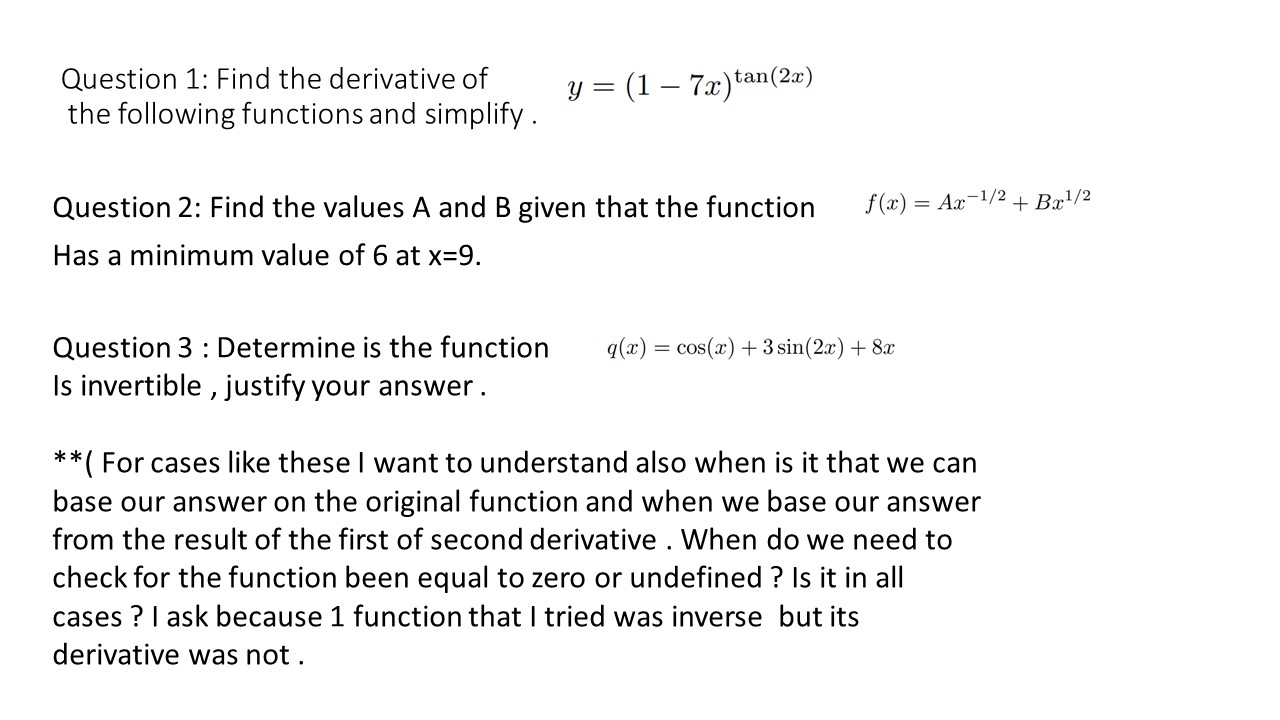



Question 1 Find The Derivative Of The Following Chegg Com




If Y Tan X Tan 2x Tan 3x Then Dy Dx Equals




Tan 2x Formula What Is Tan 2x Formula Examples




Second Derivative Of Tan 2x Youtube
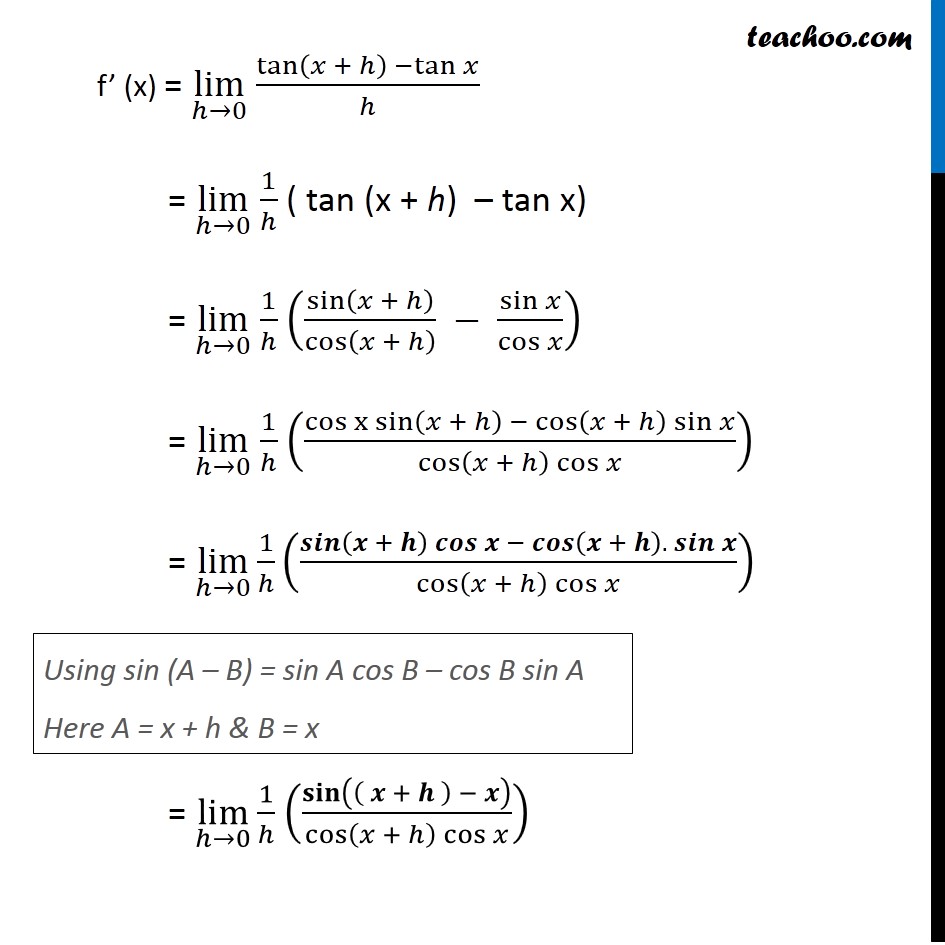



Prove That Derivative Of Tan X Is Sec 2 X By First Principle




The Derivative Of Tan X Is Sec 2 X Why Mathematics Stack Exchange



2
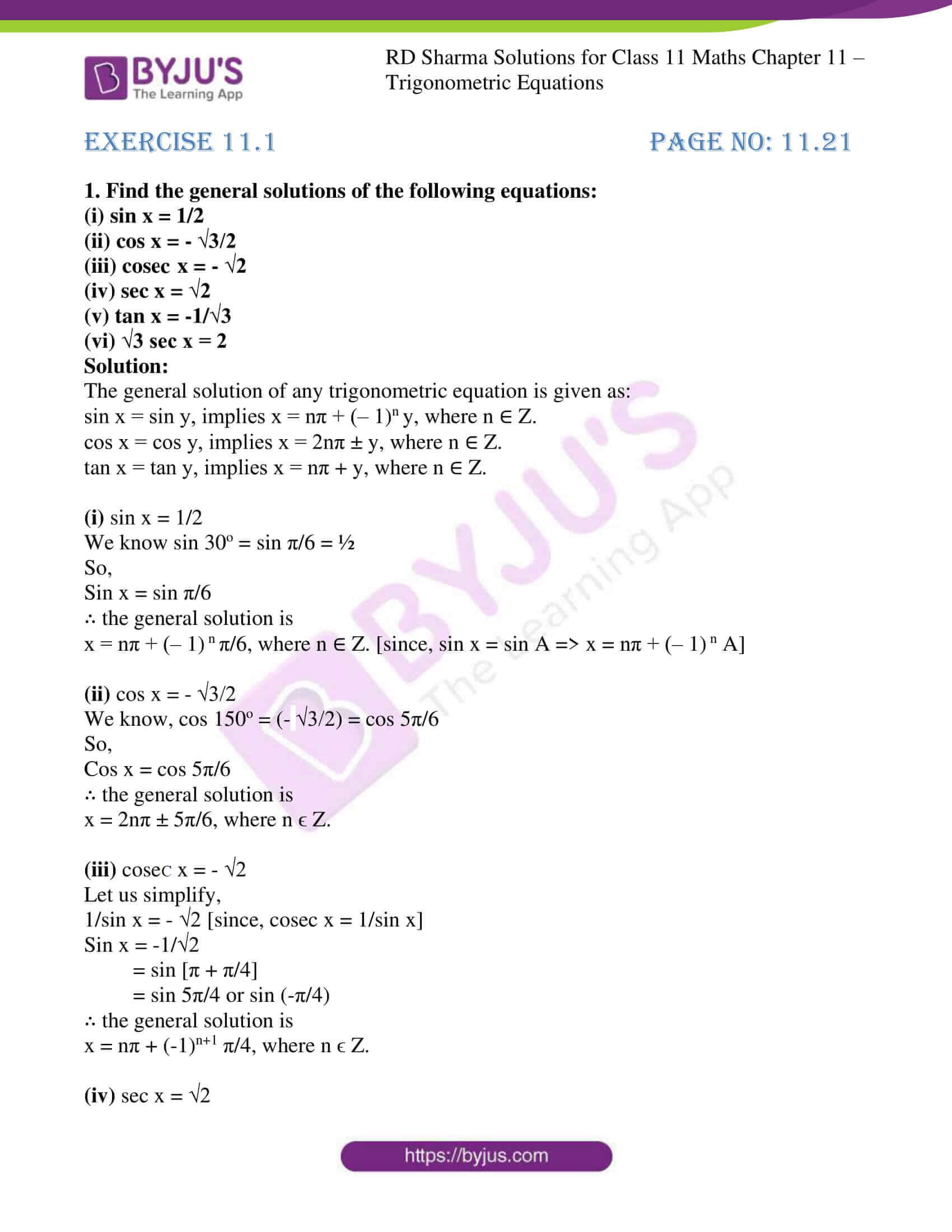



Rd Sharma Solutions For Class 11 Maths Updated 21 22 Chapter 11 Trigonometric Equations Download Free Pdf




Find The Derivative Of The Given Function Y Tan 2x 1 Cot 2x I Tried Converting The Original Function In Terms Of Sin And Cos But It Was Still Too Complicated To Be Called Simplified



2




What Is The Integral Of Int Tan 4 X Sec 3 X Socratic




Derivatives Of Trigonometric Functions Ppt Download



Ovingtonclassroom Weebly Com Uploads 1 0 6 2 Chapter 4 Review Key Pdf




If Y Tan X Tan 2x Tan 3x Sin 12x 0 Then Dy Dx Has The Value Equal To




Lim Tan2x Cot2x Secx Cosecx X Pi 4 Maths Limits And Derivatives Meritnation Com



Solved If Sin2x 3 5 Find All Possible Values Of Sin X Tan X Cos X Cot X Sec X Csc X If Cosx 3 5 Find All Possible Values Of Sin2x Tan2x Course Hero



2



Www Math Purdue Edu Kyochman Ma Lesson14 Notes Implicitdifferentiation Pdf




Find The Derivative Of Tan 2x From First Principle Brainly In
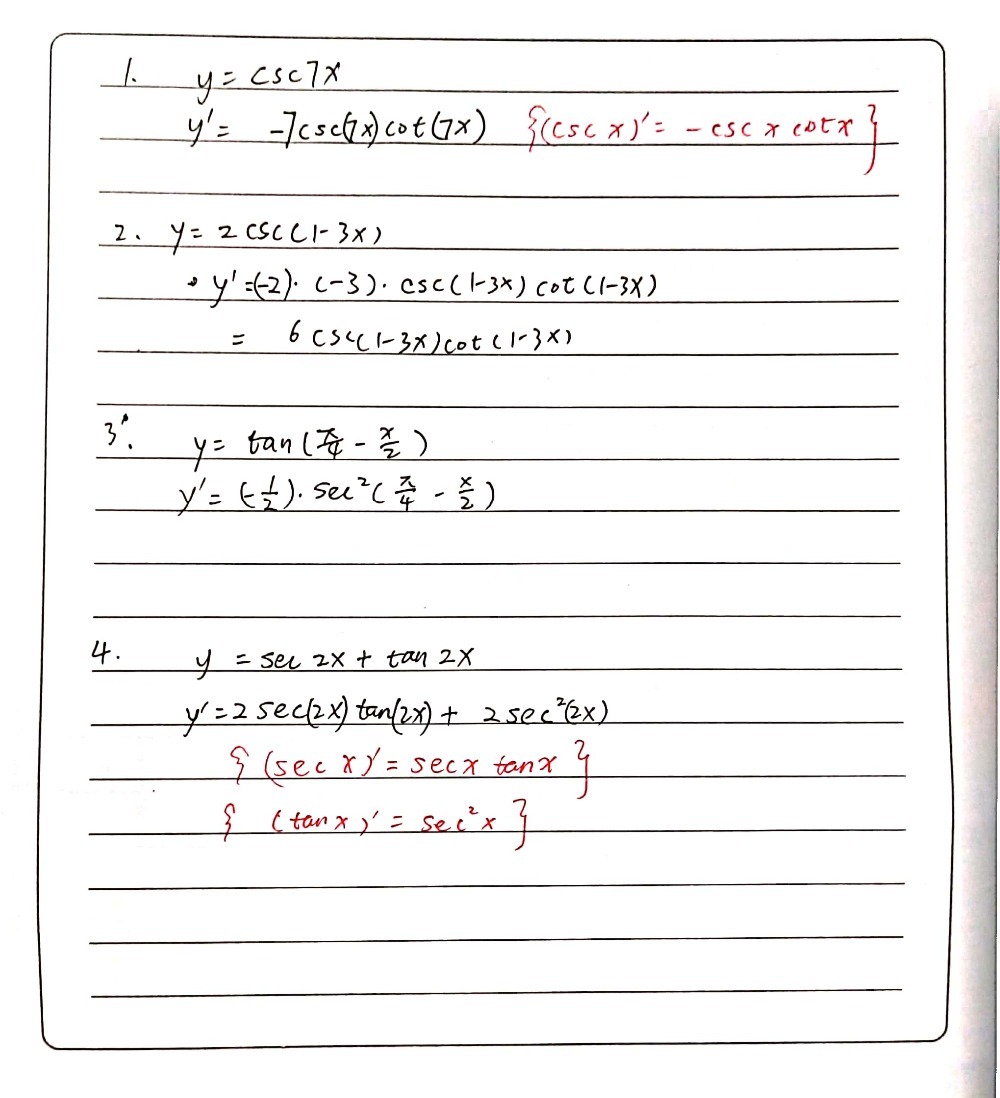



Find The Derivative Of The Following Functions 1 Gauthmath
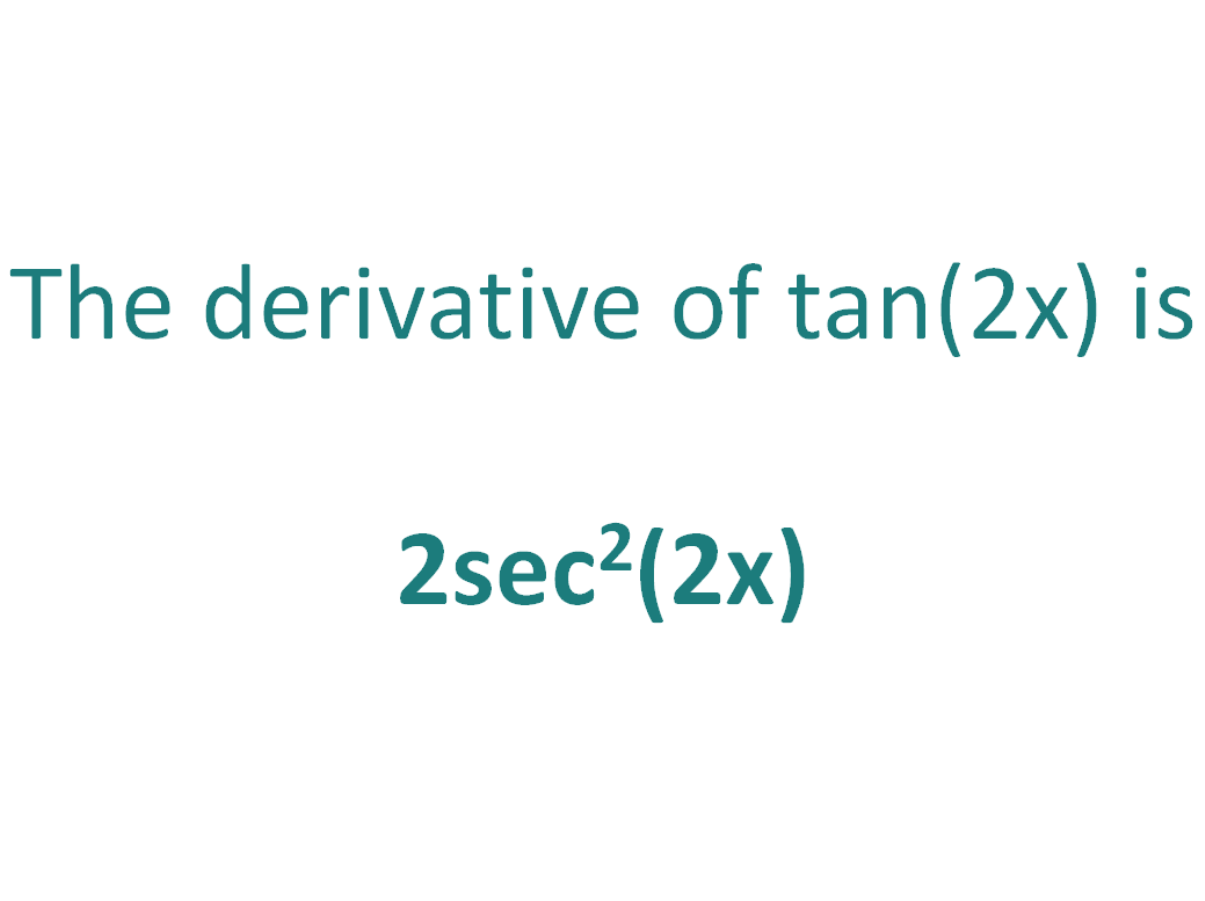



The Derivative Of Tan 2x Derivativeit




Derivative Of Tan X Old Video Khan Academy



Www Mvcc Edu Learning Commons Pdf Sp Ma151finalexamreview Pdf




Find The Derivative Of Tan 2x 3 Brainly In




Derivative Of Tan 2x 3 From First Principle Brainly In



What Is The Second Derivative Of Tanx Secx Quora




Differentiate The Following From First Principle Sin 2x 3




New Syllabus Additional Mathematics Pages 301 350 Flip Pdf Download Fliphtml5
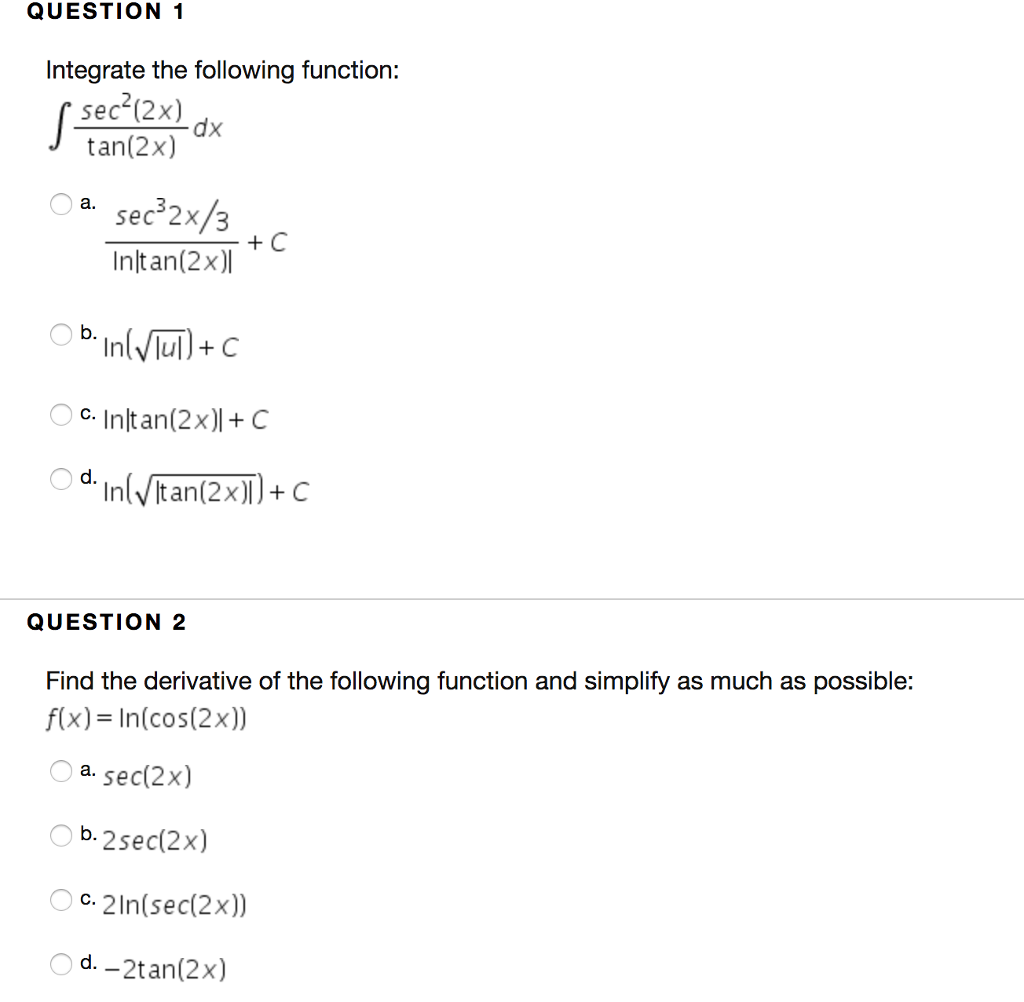



Question 1 Integrate The Following Function Sec 2x Chegg Com




The Derivative Of Tan X Is Sec 2 X Why Mathematics Stack Exchange



Http Www2 Southeastern Edu Academics Faculty Ereyes 0ch2 Pdf
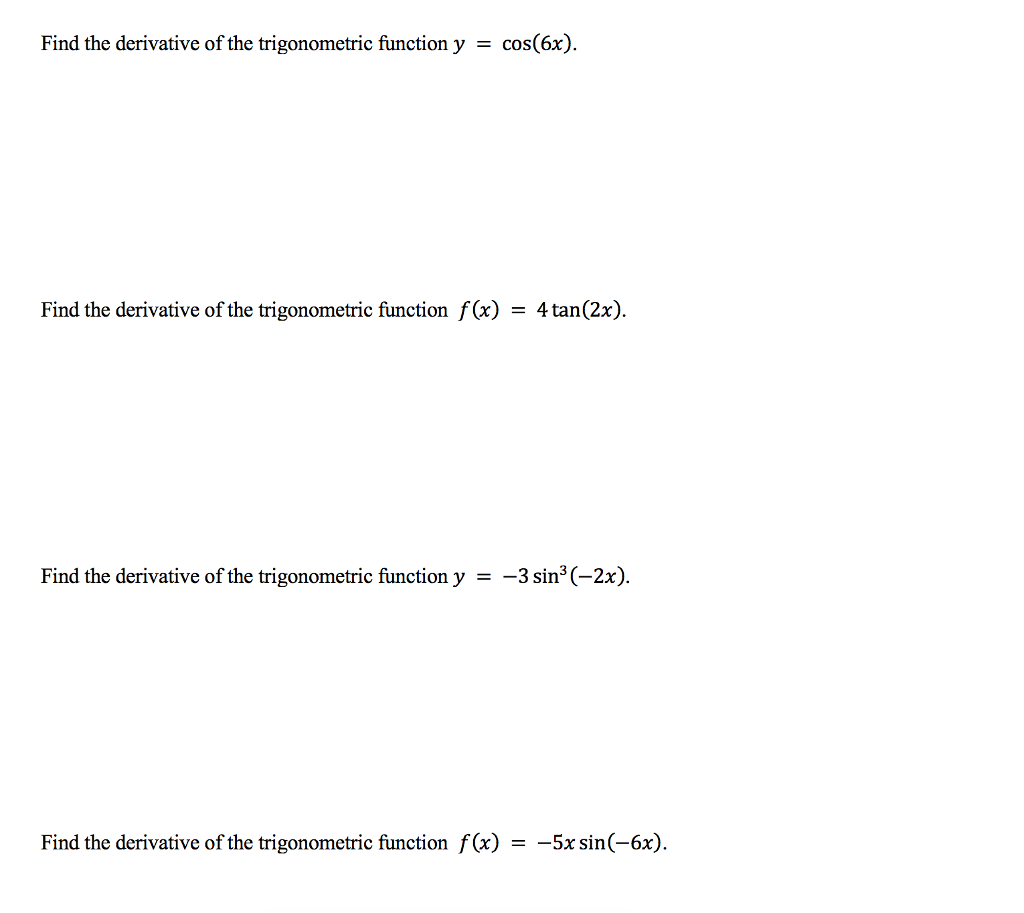



Solved Find The Derivative Of The Trigonometric Function Chegg Com




The Derivative Of H X 2 Sec 2 X Tan X Product Rule Example Youtube
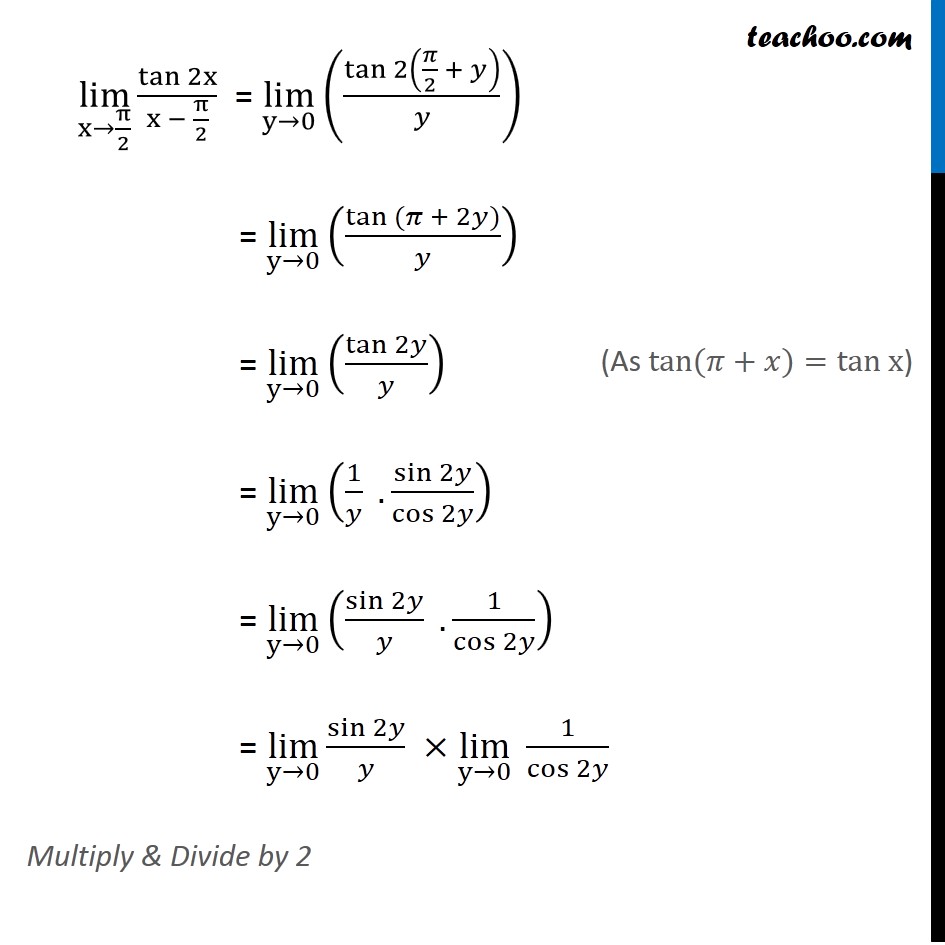



Ex 13 1 22 Lim X Pi 2 Tan 2x X Pi 2 Chapter 13 Class 11




Derivatives Of Sin X Cos X Tan X Eˣ Ln X Video Khan Academy
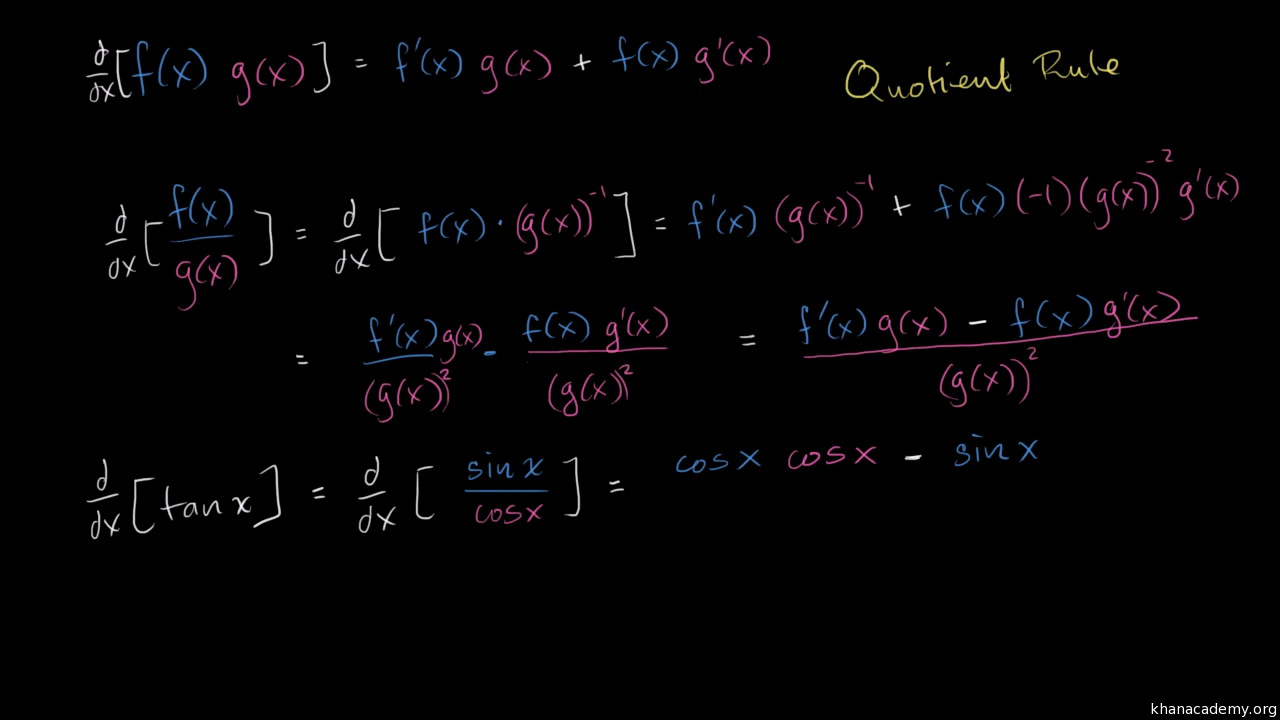



Derivative Of Tan X Old Video Khan Academy




Find The Derivative Of Tan 2x 3 Brainly In
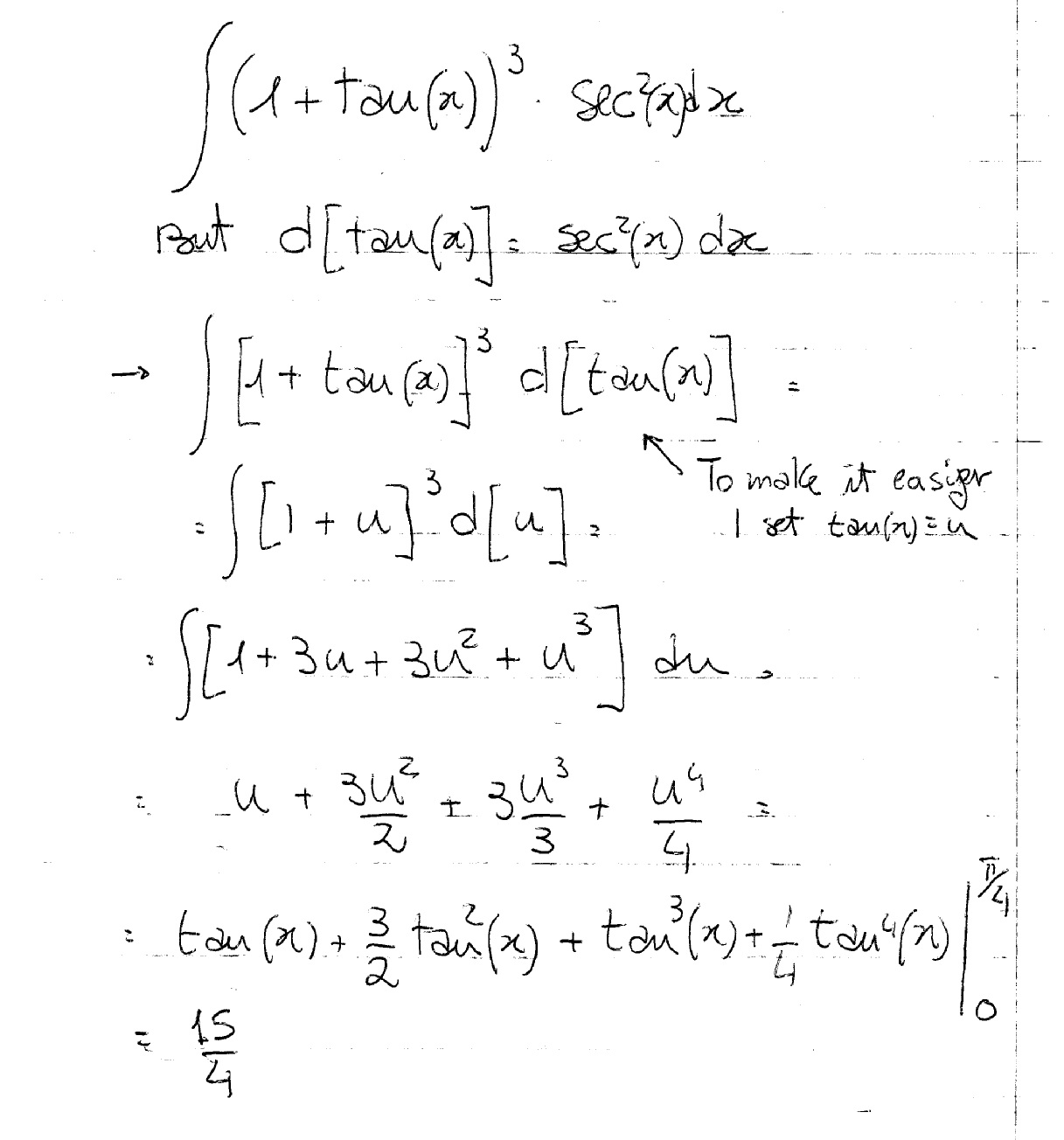



How Do You Evaluate The Integral 1 Tan X 3 Sec 2 X Dx Within The Range 0 Pi 4 Socratic




Solved The Second Derivative Of Y Tan 2 X Is A Y 2 Chegg Com




F Nd Derivative Of Tan 2 X 3
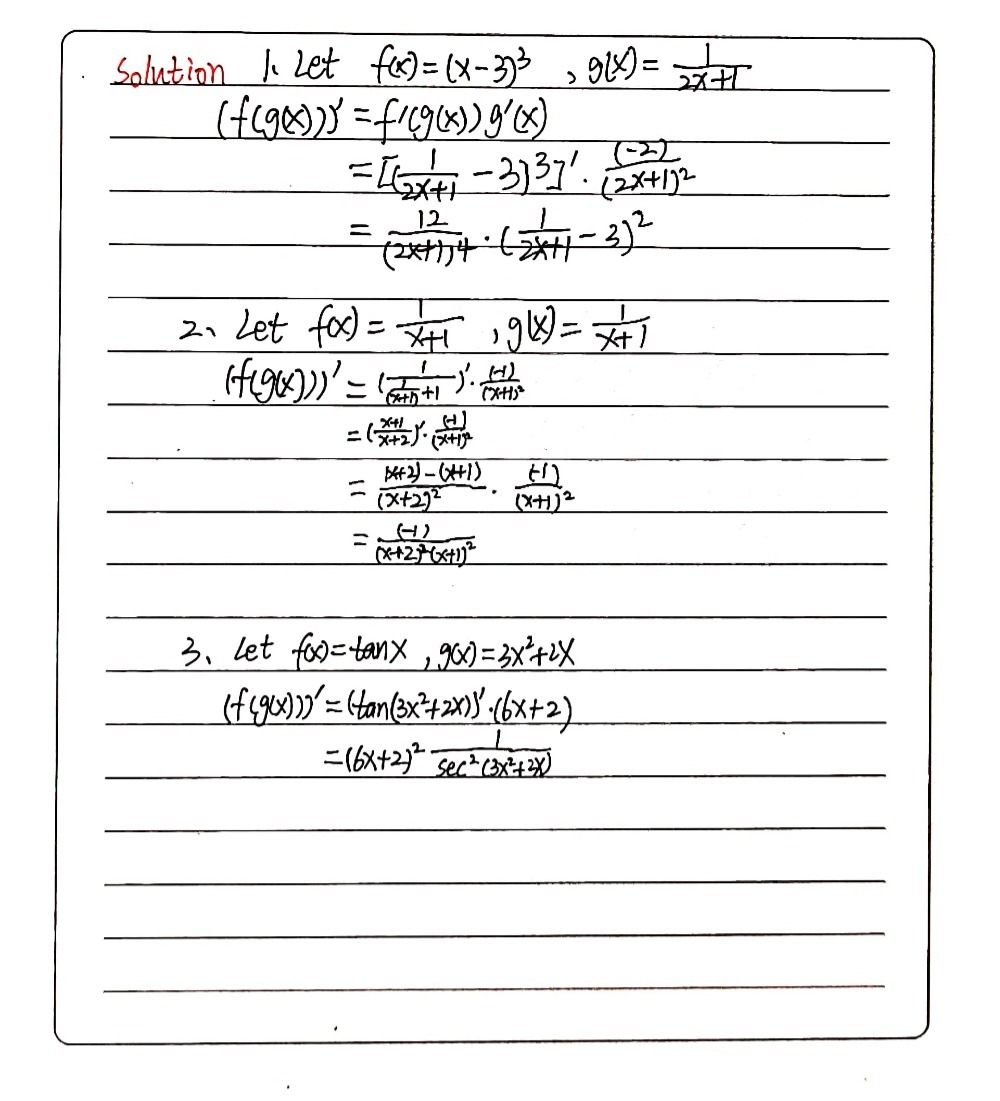



Use The Chain Rule To Find The Derivative Of The F Gauthmath



2




The Derivative Of E 5x Derivativeit
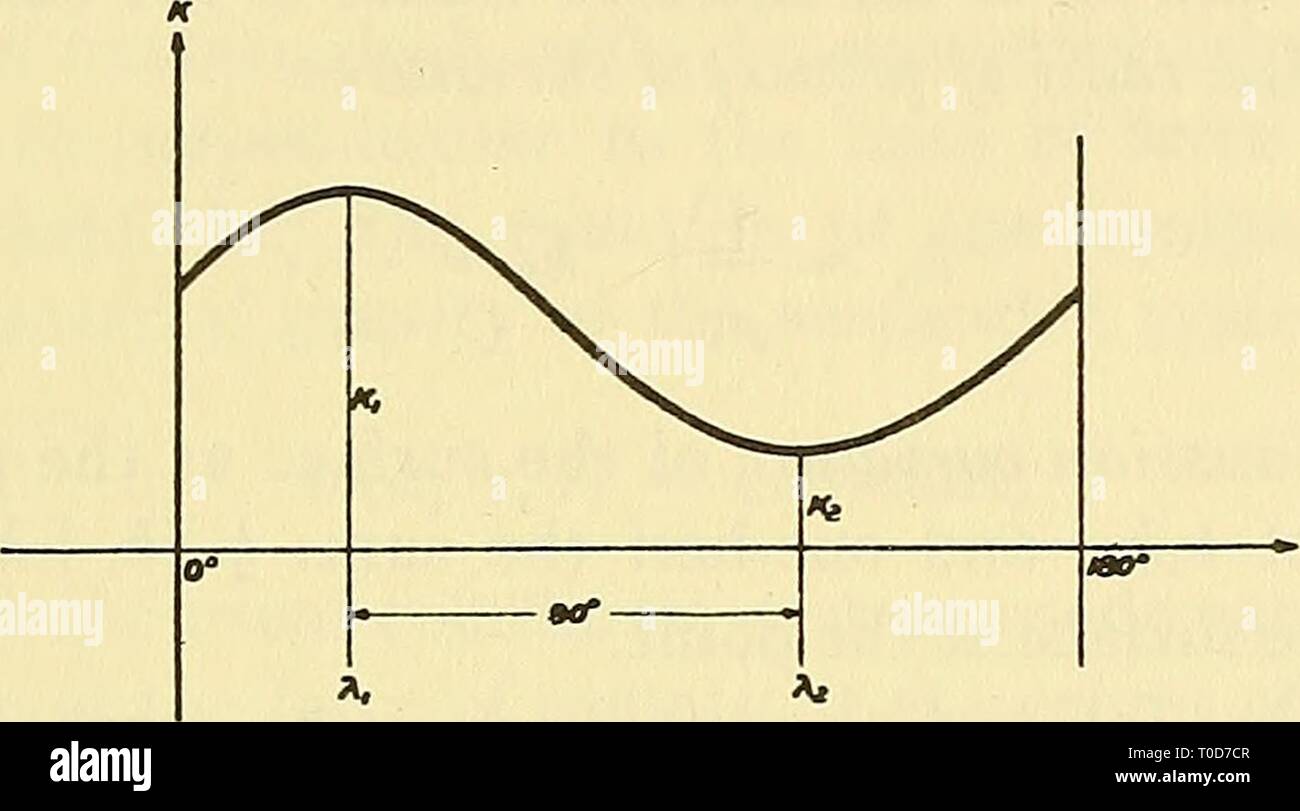



Early Geophysical Papers Of The Early Geophysical Papers Of The Society Of Exploration Geophysicists Earlygeophysical00soci Year 1947 Is Curvature Of Equipotential Surfaces 85 Dk D T R Sin 2x 2s




Find The Derivative From First Principle Of Function



Help With Letter I Finding The Derivative Calculus




Sec 2x 3 Tan 2x 3 क सम कलन क ज य Youtube




Tan 2x Formula What Is Tan 2x Formula Examples



3




05 Derivative Of Tangent Function Tan2x And Tanx 2 Youtube
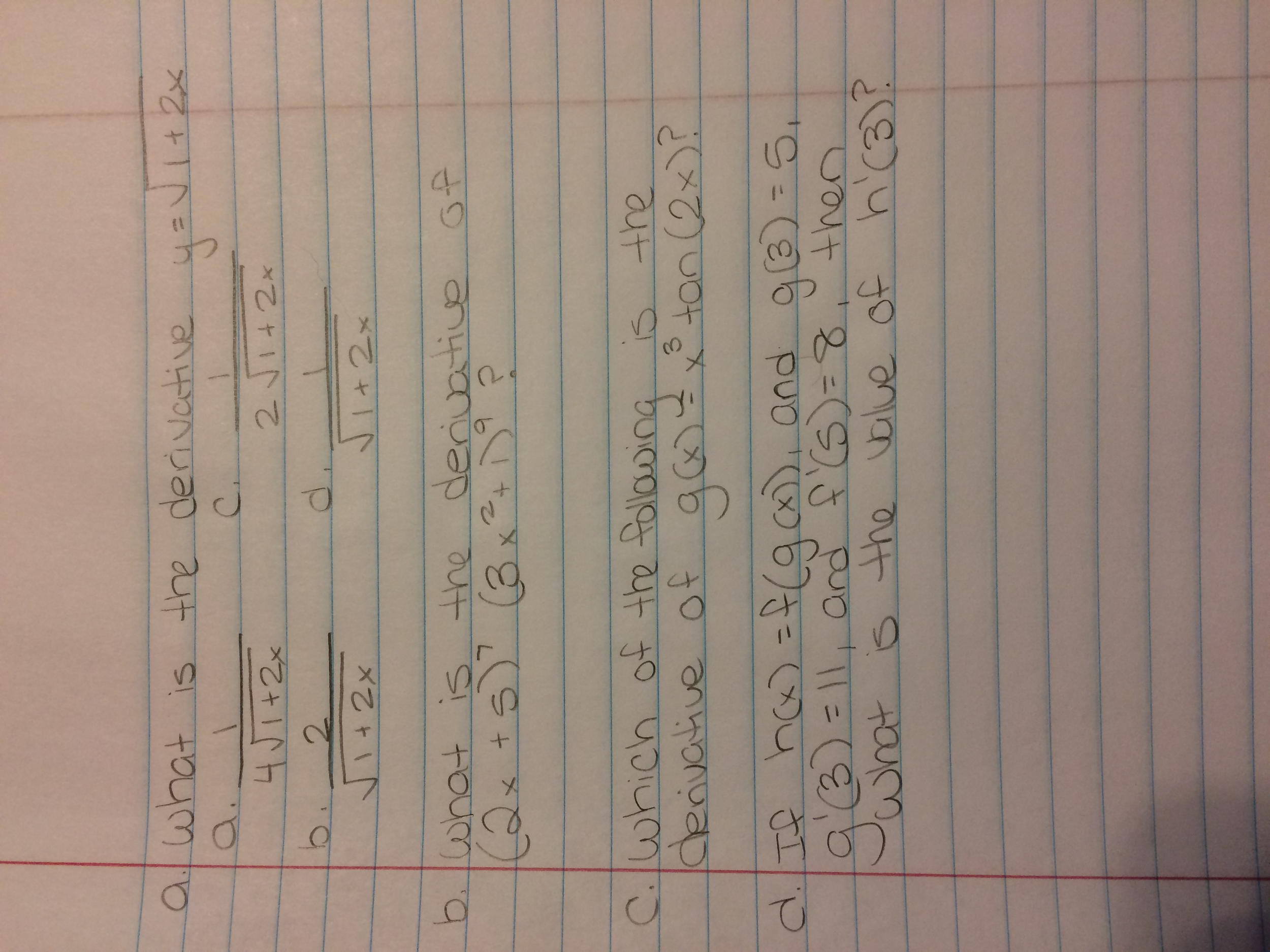



What Is The Derivative Y Square Root 1 2x 1 4 Chegg Com




Differentiate The Following From First Principle Tan 2x 1



2




Find The Derivative Of Root Tanx With Proper Steps Better If U Write It On A Piece Of Paper Brainly In




Ex 5 3 10 Find Dy Dx In Y Tan 1 3x X3 1 3x2 Ex 5 3




Tan2 Derivative ただの悪魔の画像




Derivative Rules For Trigonometric Functions



What Is The Derivative Of Tan 1 Sec X Tan X Quora




Q42 Differentiate Tan 2x 3 Derivative Of Tan 2x 3 Differentiation Of Tan 2x 3 Youtube




Derivative Of Tan 2x



Http Math Hws Edu Mitchell Math130f16 Practest2 Pdf



How To Differentiate A 2x In Fact What Is The General Rule For Functions Like A Kx Where K Is Any Constant Quora




Evaluate Lim X Sqrt 1 Sin3x 1 Ln 1 Tan2x Maths Limits And Derivatives Meritnation Com



Www Pdsd Org Cms Lib Pa Centricity Domain 181 Work and solutions to the worksheet on finding derivatives of functions using the chain rule Pdf




The Expression 1 Tan X Tan 2 X 1 Cot X Cot 2 X Has The Positive Values For X Given By
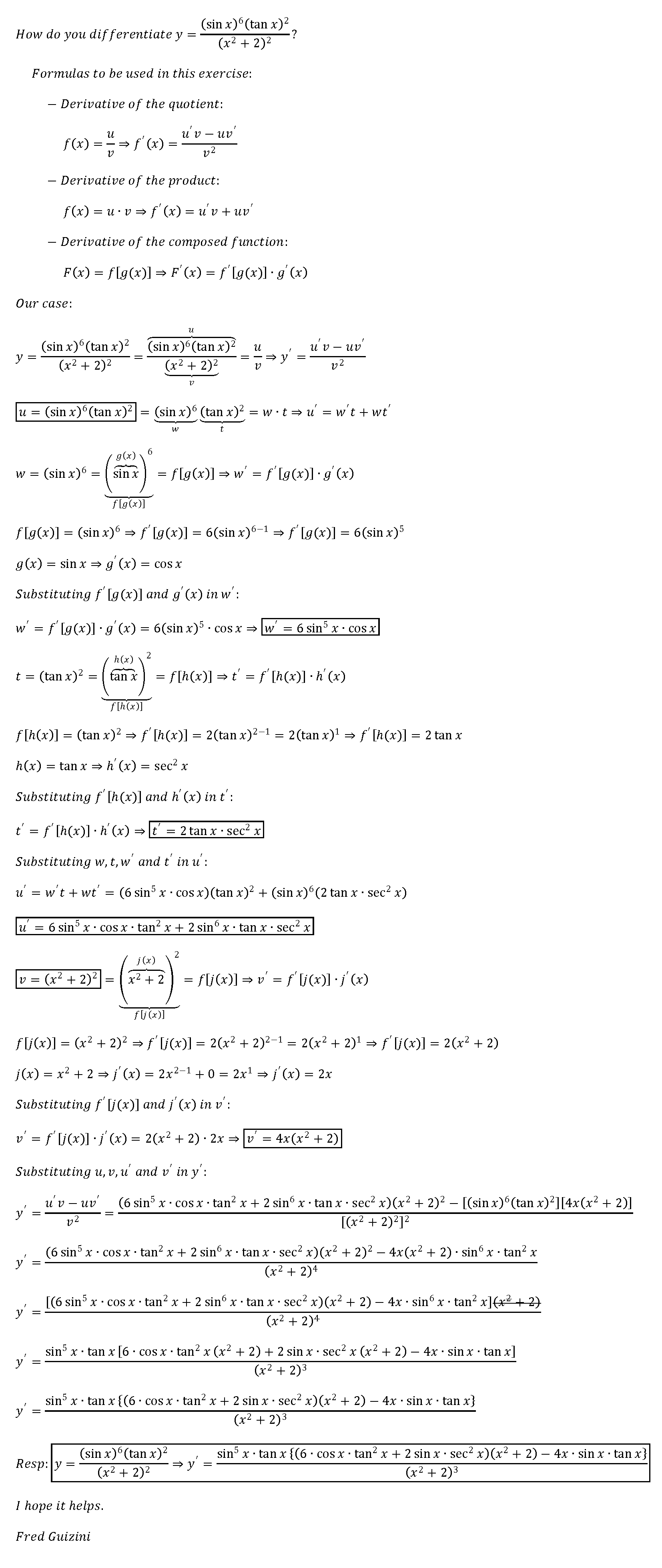



How Do You Differentiate Y Sin X 6 Tan X 2 X 2 2 2 Socratic



0 件のコメント:
コメントを投稿